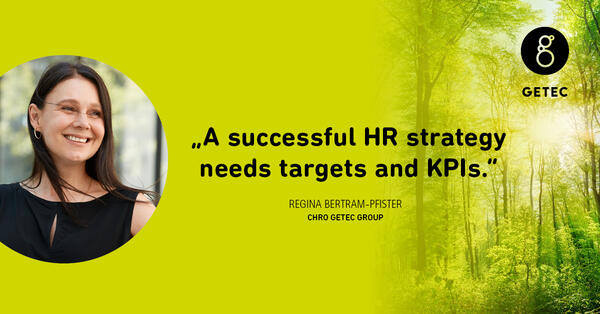A successful HR strategy needs targets and KPIs
A successful HR strategy needs targets and KPIs
You joined GETEC in May 2023. What is your personal view of the culture at GETEC?
I see a lot of fantastic talent, a great deal of enthusiasm and a positive atmosphere. This is currently reflected by our high engagement index. I also see a collaborative way of working and a very strong willingness to help each other. At the same time, there are unconscious biases, like there are in any organization. To counter these, it is important to develop a strategy that is aligned with the individual issues within the organization. This could be gender or age or other dimensions of diversity. Such honest self-reflection is crucial to addressing prejudices and developing a spirit of trust-based collaboration. There are wonderful training courses for this.
Diversity and different perspectives can also cause friction. How can we achieve a culture that sees diversity as an opportunity?
We need to communicate long-term goals openly and transparently. HR and Communication, for example, need to work well together to achieve this. The goals must be lived by our organization’s management, in the same way as openness for other opinions and a constructive error culture. Change is often associated with effort so it is important to avoid the classic pitfalls such as recruiting people with similar traits. This can be done by a continuous process of self-reflection or systematically by specially trained HR employees.
What measures are needed for the further development of GETEC’s culture?
In addition to management programs and unconscious bias training for the entire organization as mentioned earlier, there are a number of good initiatives including the GETEC Academies and the People and Culture Circle. It’s now important to network and harmonize these measures. We are in the process of reorganizing the Group and must define common denominators, goals and values for everyone. And perhaps we need to be more creative when it comes to KPIs.
How do you feel about quotas for women and men?
Quotas are important in any organization if change is to be achieved. I’ll say it quite clearly: We will only be successful if our teams are diverse. We need to focus very closely on the data – ideally tracking them on a weekly basis. The necessary effort will only be made if we have long-term KPIs and this will yield the corresponding success. And, we should not just focus on a quota for women but apply a truly broad definition of diversity. Of course, it’s not just about the quotas. We actually have to treat everyone equally. Equal pay, for example, has an important role to play here.
What should be the main KPIs for measuring organizations?
The internal fill rate should be 70%. And we need to use relevant KPIs to examine the entire employer life cycle – from employer branding to retirement. The same applies to the retention of younger employees, which is now essential. We need to consider how we can respond to young people’s need for professional development with the goal of ensuring a low fluctuation rate. In Europe, it’s not possible to track all aspects of diversity. However, as a minimum, the organization should monitor the ratio of female to male employees and the age structure and develop targets on this basis.
Is there a genuine need to foster women specifically or not at present?
I think there is great potential there. I’ve had good experience with women’s networks for training and inspiration from external business leaders, for example. A network like this can be a real incubator for high potentials. Networking among managers and the joint fostering of talents are also extremely important and should be given greater attention. The key question for anyone in a management position is how to involve their employees, make them visible and enable them to shine. This requires the necessary leadership skills which have to be learned.
What can organizations do in order to build these leadership skills?
Very important here are the corporate purpose and corporate values, which are evident in the way employees collaborate. When it comes to leadership style, especially for senior managers, I favor a situational approach that takes account of the situation and diversity of the teams and individuals. Good leadership is something that needs to evolve constantly.
How can KPIs generate greater momentum and support for HR issues within the organization?
In my experience, dashboards can help by demonstrating the positive relationship between business growth and employee engagement. If everyone in the organization is to feel included, simple figures are needed. At GETEC, we can take very specific information from Gallup surveys, create a dashboard and share this in order to visualize the relationships and their interaction within the overall strategy.
Regina Bertram-Pfister studied law and came to GETEC from Ingersoll Rand, a leading U.S. manufacturer of industrial products, where she was Head of HR for the DACH (Germany, Austria, Switzerland) region and, as the HR business partner for the life sciences segment, responsible for the global HR strategy.
We embody partnership –
find your contact.
With more than 50 locations throughout Europe, we are always at your doorstep.
Contact us. We are here for you.

 © Patrick Desbrosses
© Patrick Desbrosses